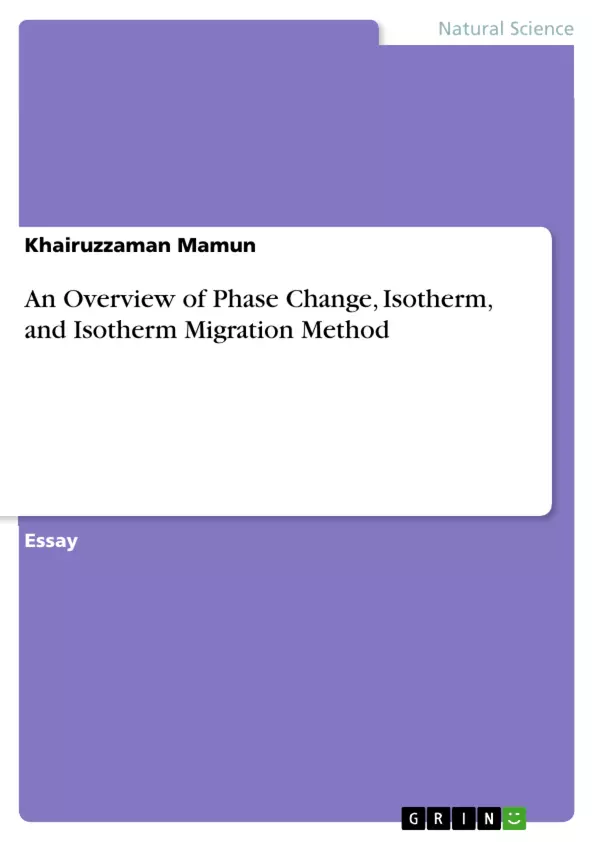Phase change, isotherm and isotherm migration method are very important terms to learn in thermodynamics. This article is aimed at presenting the definition and mathematical discussion of some important thermodynamic terms such as phase change, isotherm and isotherm migration method etc. It offers an overview of some theoretical literature on these topics and presents their interpretation. Phase-change, Isotherm, Stefan Problems, and Isotherm Migration method are described with graphical or mathematical representation to clarify the concepts so that one can get brief idea about them.
This study focuses on different types of discussion about the phase change, isotherm, and isotherm migration method. From this article one can get a brief idea about the phase change and isotherm migration method. The essay offers definitions of the terms ("phase change", "isotherm"), explains the Stefan problems and offers methods of solution.
Frequently asked questions
What is the purpose of this document?
This document provides a comprehensive language preview, including the title, table of contents, objectives and key themes, chapter summaries, and key words for a text. It aims to present the definition and mathematical discussion of some important thermodynamic terms.
What are the key thermodynamic terms discussed?
The key terms discussed include Phase-change, Isotherm, Stefan Problems, and Isotherm Migration method.
What is Phase-change?
Phase transition or phase change describes transitions between solid, liquid, gaseous states of matter, and plasma. During a phase transition, certain properties change due to changes in external conditions like temperature or pressure.
What is an Isotherm?
The term Isotherm means keeping the same temperature at a given time or on average over a given period.
What are Stefan Problems?
Stefan problem is a particular kind of boundary value problem for a partial differential equation (PDE), adapted to the case in which a phase boundary can move with time. It aims to describe temperature distribution during a phase change (e.g., ice to water).
What are the methods of solution for Stefan Problems?
Methods of solution include analytical solutions and numerical methods based on finite-difference replacements of the original partial differential equation. Examples include special finite-difference formulas, unequal time intervals, grid deformation, modified specific heat, and moving the entire grid with the boundary.
What is the Isotherm Migration Method (IMM)?
The Isotherm Migration Method (IMM) is a method for tracking a moving boundary that occurs at a fixed temperature. It involves expressing the space variable 'x' as a function of temperature 'u' and time 't', so that x = x(u, t), and calculating the positions of a given temperature (isotherm) at known times.
How is melting ice described in the document?
The melting ice example describes a plane sheet of ice initially occupying a region and being melted by the application of constant temperature. It provides a mathematical framework for describing the heat flow and boundary conditions during the melting process. Equations are derived to relate heat flow, latent heat of fusion, and temperature gradients.
What are the initial and boundary conditions for the melting ice problem?
The initial condition is that the ice is at 0 degrees. Boundary conditions include a constant temperature applied at the surface, and conditions at the moving boundary separating the water from the ice that relate the heat flow to the latent heat of fusion.
What is the numerical approximation used for the Isotherm Migration Method?
The derivatives in the equations are approximated by finite differences to obtain an explicit expression for the value of X at a future time step in terms of values already available at previous time steps.
What is the stability criterion for the finite difference scheme in IMM?
The criterion is related to the coefficient of temperature gradient, is less than 1/8 (the difference in the value of x across 2 steps - value of x at a current step) squared, this criterion allows to change as the solution proceeds.
Where can I find the references for these concepts?
A list of references is provided at the end of the document, citing various articles and books on conduction of heat, finite difference methods, and the Isotherm Migration Method.
- Quote paper
- Khairuzzaman Mamun (Author), 2017, An Overview of Phase Change, Isotherm, and Isotherm Migration Method, Munich, GRIN Verlag, https://www.grin.com/document/376165



